|
|

This chapter describes how to access the Cisco Voice Routing Center (VRC) server from a GUI console.
This chapter contains the following sections:
Certain server-based procedures are executed from the console instead of the VRC client. Because the console runs on the Sun server, you access it using the X protocol. We recommend that you use a Sun terminal, but you can also use a PC-based X package, such as Virtual Network Computing (VNC) server.
 |
Note If you choose to use VNC viewer, you must install VNC server on the server where the VRC server resides. |
To open the Cisco VRC console from your X terminal, follow these steps:
Step 1 Open your Xclient application (or VNC server).
Your application might require you to enter a host name (IP address of the Xserver) and your password.
Step 2 If you must provide an IP address, then enter the IP address. Enter your password and click OK. A terminal work space session opens.
Step 3 From the workspace menu, right-click and choose Terminal, Tools, and then the Terminal option from the menus. A terminal session opens.
Step 4 Enter the start_console.sh command:
start_console.sh
The VRC Console Login dialog box appears.
Step 5 Enter your name and password and press OK. The VRC Console window appears (Figure 8-1).

The VRC Console window has the following tabs:
 |
Note User Administration appears under the Security area of operation; but it is managed through the CNS Security Services user interface. For detailed CNS Security information, see "CNS Security Services Administration." |
To establish a connection with the VRC server from the console, follow these steps:
Step 1 From the VRC console window, click the Service Startup tab.
Step 2 Click the Connect to VRC Server button.
 |
Note If the VRC server status is running, you are already connected and you receive a message indicating that there is an existing session. Forced login can be caused by the same user login from the VRC client. Because only one active client session can be opened on the VRC server; if the user chooses a forced login, then another session from the VRC client will be closed. |
Step 3 Enter your user name and password.
Step 4 Click OK to connect to the VRC server or click Cancel to cancel this procedure.
You can shut down the VRC server from the console or a UNIX shell.
This procedure does not shut down any other processes that VRC might be using (for example, Tomcat or MySQL).
To shut down the VRC server from the console, follow these steps:
Step 1 From the VRC console window, click the Service Startup tab.
Step 2 Click the Shutdown VRC Server button. A Confirm dialog box appears.
Step 3 Click OK to confirm the shutdown or click Cancel to cancel the shutdown.
To shut down the VRC server software from the UNIX shell, follow these steps:
Step 1 Log in as the VRC system user.
Step 2 Run the script:
stop_gdpm.sh
stop_server.sh -u <username> -p <password>
This script is located in $HOME/gdpm/scripts directory.
This stops the VRC server, Tomcat, and MySQL server processes. The MySQL process must be shut down after the VRC server process as the VRC server requires the MySQL database engine for its operation.
This section describes the operation functions from the Operations tab in the VRC Console window (Figure 8-2).
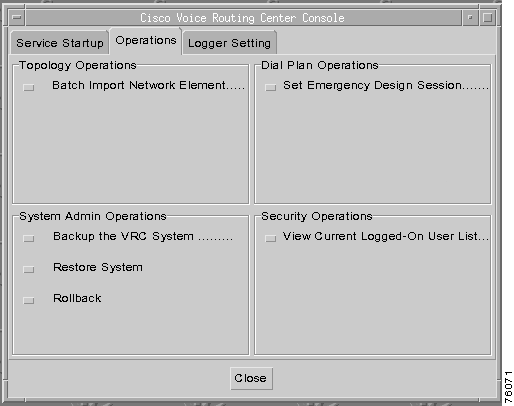
The Topology Operations area in the Operations tab (Figure 8-1) displays the Batch Import Network Element button.
This section describes how to perform batch imports of network elements from the console. A network element must be added to the topology before it can be used in the dial plan.
 |
Note You must check with your system administrator to see if you have user privileges. |
To perform a batch import from the console, follow these steps:
Step 1 From the VRC Console window, click the Operations tab.
Step 2 Click the Batch Import Network Element button. The Choose Batch Import File dialog box appears (Figure 8-3). This dialog box lists available folders and files to import the network elements from. The path or folder name is the path to the VRC server.
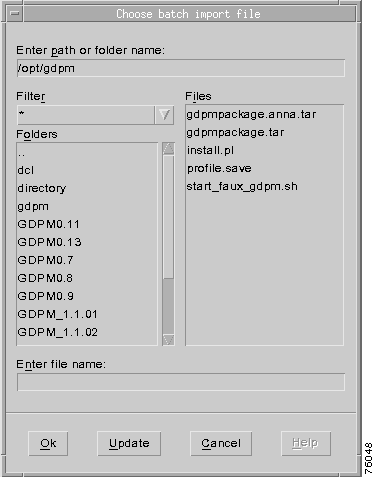
Figure 8-3 lists available folders and files to import the network elements from. Use this format to set up your network topology files.
Step 3 Enter the path or folder name which is the path to the VRC folder.
Step 4 Enter the folder and filename to import.
Step 5 Click OK to import the file.
Step 6 You are asked to confirm your selection. Click OK.
An Information dialog box appears and informs you if the import is successful. Click OK to confirm or click Cancel to cancel this operation.
The Dial Plan Operations area in the Operations tab (Figure 8-2) displays the Set Emergency Design Session button.
If there is already an active design session and you need to make an urgent change to the dial plan, you can set an emergency design session through the VRC console from the Operations tab.
 |
Note Any user who has the dp-admin privilege can perform an emergency design operation for a specific scope from the VRC console. |
There are four possible reasons for using this option. A user has an active design session at the:
When the second user sets an emergency design session, the design session for the first user is closed. The user is notified that the session is closed and a design file is created. The design file name includes the time stamp, user name, scope, and file type. The first user is not logged out of the VRC server.
To set an emergency design session, follow these steps:
Step 1 From the VRC console window, click the Operations tab.
Step 2 Click the Set Emergency Design Session button under Dial Plan Operations area. The Set Emergency Design Session window appears with a list of active designs (Figure 8-4).
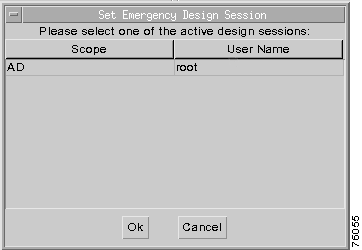
Step 3 Select the scope you need to close. Choose a region or the AD.
Step 4 Click OK. A Confirm dialog box appears.
Step 5 Click OK to confirm your selection or click Cancel to cancel this procedure. An Information dialog box informs you if the operation is successful.
Step 6 Click OK.
The following sections describe the functions in the System Admin Operations area (see Figure 8-2) in the Operations tab:
To back up the VRC database and directories from the console, follow these steps:
Step 1 From the VRC console window, click the Operations tab.
Step 2 Click the Backup the VRC System button from the System Admin Operations area.
The Create Backup File window appears (Figure 8-5).
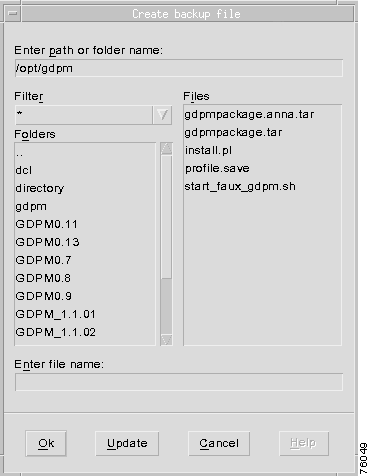
This window lists existing folders and files and the path or folder name which is the path to the VRC server.
Step 3 Enter the file name that you want to back up. You can select from existing files or enter a new file.
Step 4 Click OK to back up the file.
Step 5 Click Update to add this filename to the directory listing or click Cancel to cancel this procedure. A Confirmation dialog box appears.
Step 6 Click OK to confirm your selection.
An Information dialog box informs you if the import is successful. Click OK.
The Restore procedure overwrites the existing directory.
To restore the VRC system, follow these steps:
Step 1 From the VRC Console window, click the Operations tab.
Step 2 Click the Restore System button from the System Admin Operations area.
The Restore System window appears (Figure 8-6).
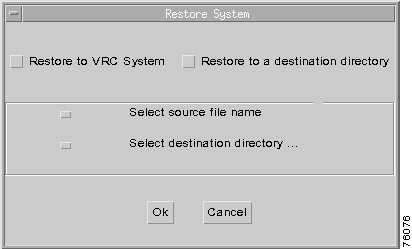
The Restore System window displays two restore buttons:
Choose where you want to restore the system to.
Step 3 If you choose Restore to VRC System, this restores the VRC system to a previously backed-up configuration.
a. Click the Select source file name button to open a window.
b. Enter a folder and file name.
c. Click OK in the Choose restore source directory browser window.
Step 4 If you choose Restore to a destination directory, the server automatically restarts. This operation can be used to review the data you want to restore but does not make any changes to the system.
a. Click the Select source file name button to open a browser window.
b. Enter a folder and file name.
c. Click OK in the Choose restore source directory browser window.
d. Click the Select destination directory button to open a browser window.
e. Enter a folder and file name.
f. Click OK in the Choose restore destination directory window.
Step 5 Click OK in the Restore System window. You are asked to confirm your selection.
Step 6 Click OK to restore the system or click Cancel to cancel the procedure.
A rollback is a VRC function that:
 |
Note If you execute a Discovery for a region or AD and cancel before the operation is complete, the configurations that were discovered before the cancellation are still stored in the /origconfig directory. Furthermore, a second discovery does not overwrite these files. If you execute a rollback, the configuration stored in the /origconfig directory is used. |
 |
Note You cannot execute a rollback if you have made changes to the topology since the first Discovery operation (for example, changing an IP address or removing an element), or if you have changed the original Discovery information. |
To return a dial plan to its original configuration, follow these steps:
Step 1 From the VRC console window, click the Operations tab.
Step 2 Click the Rollback button from the System Admin Operations area.
A Confirm dialog box appears (Figure 8-7).
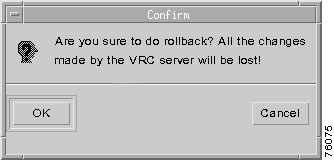
Step 3 Click OK to roll back to the original configuration discovered for each element or click Cancel to cancel this operation.
The Security Operations area in the Operations tab (Figure 8-1) displays the View Current Logged-On User List button. The Security Operations allows you to only view users currently logged on to the VRC.
To review current users, follow these steps:
Step 1 From the VRC Console window, click the Operations tab.
Step 2 Click the View Current Logged-On Users List button from the Security Operations area. A Current Logon Users window appears with a list of account names.
Step 3 When you finish reviewing this list, click OK.
Security Administration appears under the Security area of operation but it is managed through the CNS Security Services user interface. For detailed CNS Security information, see "CNS Security Services Administration."
This section describes how to set up debugging for selected subsystems. You can turn debugging on or off for one or all subsystems.
Logger levels are the different filters for logging error messages, for example, debug. It refers to the tags on the error messages.
 |
Note When you enable debugging from the console, it is only persistent until theVRC software is restarted, at which time the default setting of disabled is reinstated. |
The following debug logs are located in the /opt/vnm/gdpm/data/log directory:
To set up debugging, follow these steps:
Step 1 From the VRC Console window, click the Logger Setting tab. The Logger Setting window appears (Figure 8-8).
 .
.
Step 2 Select the subsystem that you want to change the setting for.
From the Logger Setting window, you can:
Step 3 To turn debugging on for one subsystem, follow these steps:
a. Select Debug from the Logger Level list and the subsystem (Validation, for example) from the Debug-Off Systems list.
b. Click the Activate One button. The selected subsystem is moved to the Debug-On Systems list.
Step 4 To turn debugging on for all subsystems, follow these steps:
a. Click the Turn all on button.
b. A Confirm window appears asking if you want to turn the debug on for all subsystems.
c. Click OK to move all subsystems to the Debug-On Systems list or click Cancel to cancel the procedure.
Step 5 To turn debugging off for one subsystem, follow these steps:
a. Select Debug from the Logger Level list and the subsystem (Validation, for example) from the Debug-Off Systems list.
b. Click the Deactivate One button. The subsystem is moved to the Debug-Off Systems List.
Step 6 To turn debugging off for all subsystems, follow these steps:
a. Click the Turn all off button.
b. A Confirm window appears asking if you want to turn the debug off for all subsystems.
c. Click OK to move all subsystems to the Debug-Off Systems list or click Cancel to cancel the procedure.
Step 7 Click the Close button to close the Logger Setting window.
To close the console window, follow these steps:
Step 1 See Connecting to and Shutting Down the VRC Server to access the Service Startup window.
Step 2 Click the Close button at the bottom of the window.
The console window closes.
Step 3 Exit your Xclient application. Type exit to close the console terminal window.
![]()
![]()
![]()
![]()
![]()
![]()
![]()
![]()
Posted: Mon Oct 14 09:54:22 PDT 2002
All contents are Copyright © 1992--2002 Cisco Systems, Inc. All rights reserved.
Important Notices and Privacy Statement.